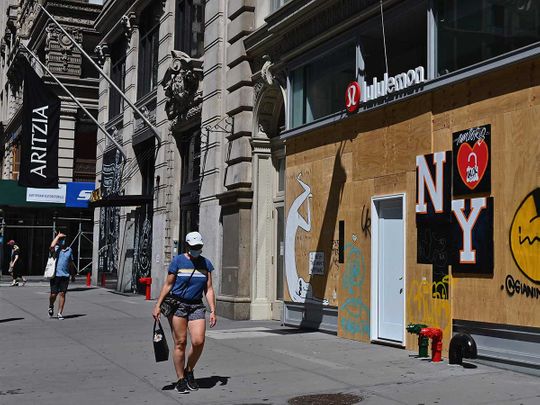
New York: A few months ago, New York was suffering through the worst ravages of the coronavirus pandemic. Hospitals filled to near capacity. Hundreds of people died each day, reaching a peak in mid-April.
The rest of the country recoiled at the sight of a New York licence plate. Florida and Rhode Island singled out New York travellers, who researchers now believe helped to seed the spread of the virus in other states.
But as New York has largely controlled its outbreak, other states - especially in the Sun Belt and the West - have seen virus cases surge, leading to a table-turning moment: Gov. Andrew Cuomo on Wednesday announced that anyone coming to New York from a state currently hard hit by the virus would have to quarantine for two weeks.
The restrictions were based on specific health metrics related to the coronavirus, Cuomo said. At the moment, travellers from eight states - as well as New Yorkers returning from those states - would have to quarantine.
“We now have to make sure that the rate continues to drop,” Cuomo said. “A lot of people come into this region and they could literally bring the infection with them. It wouldn’t be malicious or malevolent, but it would still be real.”
Fines
Failure to quarantine in New York could result in thousand-dollar fines, Cuomo said. Travellers to New Jersey and Connecticut would also be told to quarantine, although officials from both states said there was no enforcement mechanism at the moment.
The order - a “joint travel advisory” with the two other states - would take effect at midnight, Cuomo said Wednesday. He said the quick implementation was aimed at preventing a rush of travellers trying to avoid the requirement, which currently applied to Alabama, Arizona, Arkansas, Florida, North Carolina, South Carolina, Texas and Utah.
Washington state had originally been included, but after a further review of the data, it was dropped from the list.
As businesses reopen and public life returns, the virus has been spreading to areas that had mostly managed to initially evade the worst of the outbreak.
Record-levels of hospitalisations
In recent days, Texas has seen record-high levels of hospitalisations for COVID-19, the disease caused by the coronavirus. Hospitals, particularly in Houston, have struggled to keep up with the rising number of patients needing intensive care. “There is a massive outbreak of COVID-19 across the state of Texas,” Gov. Greg Abbott said in a television interview Wednesday.
Amid rising hospitalisations in North Carolina, Gov. Roy Cooper said Wednesday that the state would “pause” its move into the next phase of reopening and make masks required statewide in public when distancing is not possible.
In Florida, more than 20,000 people tested positive for the virus over the five days ending Tuesday; in New York, where far more people are being tested daily, roughly 3,100 tested positive over those same five days.
Only a handful of states - including Maine, Rhode Island and Hawaii - have required out-of-state travellers to quarantine. A larger number have asked travellers to quarantine but have not mandated doing so. And a few, such as Florida and Kansas, apply the requirement only to those coming from certain states.
The new quarantine in New York, New Jersey and Connecticut would apply to any person arriving from a state with a positive test rate higher than 10 per 100,000 residents, or a state with a 10% or higher rate over a seven-day rolling average.
Cuomo said that enforcement would be up to each of the three states. In New York, he said, those violating the quarantine order could be “subject to a judicial order and mandatory quarantine.” A first violation could result in a $2,000 fine and could go up to $10,000 for subsequent violations.
Poor enforcement
Indeed, the effect of the order may be largely symbolic. Even in places where out-of-state arrivals are already formally required to quarantine, there has not been widespread enforcement to make sure the rules are being followed.
A spokesman for Cuomo said that if a New Yorker believes that a recent arrival - or a returning neighbour - has not been abiding by the quarantine, then that person should start by reporting the possible violation to the local health department.
“You could argue that every law is the honour system until you get caught,” Cuomo said. “You can violate the quarantine until you get caught,” he added, then “you’re in mandatory quarantine and fined thousands of dollars.”
Players exempt
Players from the New York Mets and New York Yankees who have been in Florida but are coming back to New York for an abbreviated and late spring training will not be required to quarantine, Cuomo said. The state had been working on separate “health protocols” with them since last week, he said.
Cuomo, who hosted the news conference from New York City, was joined via video link by Gov. Philip Murphy of New Jersey and Gov. Ned Lamont of Connecticut, all three Democrats.
“This is a smart thing to do. We have taken our people, the three of us, these three states, through hell and back,” Murphy said. “The last thing we need to is subject our folks to another round.”
The goal, the governors said, was to maintain the hard-fought gains against the virus that have been made, at great economic and human cost, over the past three months. On Monday, for example, nearly 49,000 people were tested for the virus in New York, with just shy of 600 coming back positive.
Since the middle of March, New Yorkers have largely abided by the orders to stay at home and wear masks in public, creating a new way of life in the city and surrounding suburbs that helped to bring new infections down to a manageable level.








